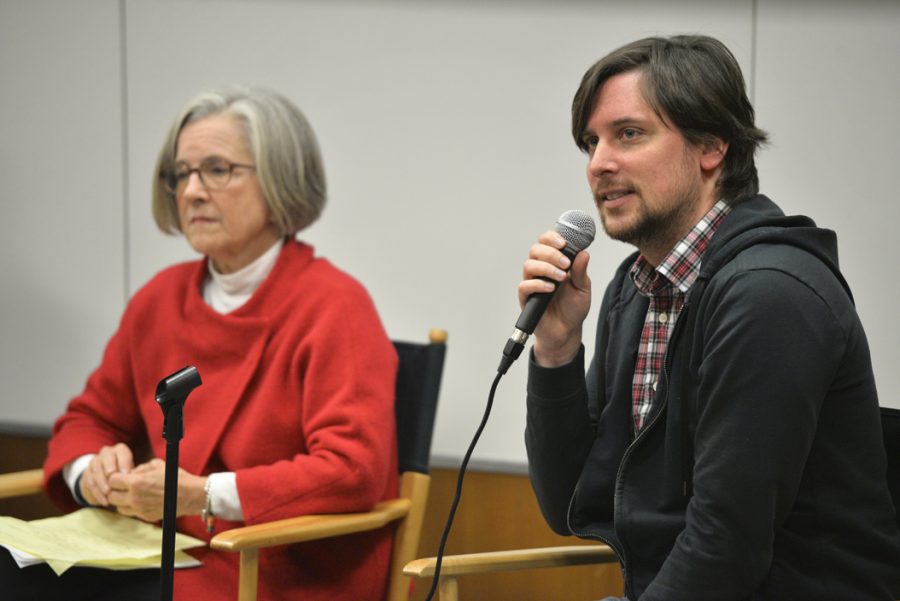It was a beautiful day in the neighborhood Thursday for Pitt students looking to learn about the TV and film industry.
A crowd of more than 50 Pitt community members gathered in Scaife Hall for “Making TV,” a panel made of five production team members from the Fred Rogers Company. The panel met to talk about the process of creating their respective programs — “Daniel Tiger’s Neighborhood,” “Peg + Cat” and “Odd Squad” — as well as the origins of the Pittsburgh-based children’s television program, “Mister Rogers’ Neighborhood.”
The event was part of the Steeltown Entertainment Project Spotlight Series, a continuous series of workshops and lectures focused on bringing together entertainment industry professionals to share their experiences. Co-sponsored by Pitt In Hollywood Club, the events in the series take place across campus and address a variety of entertainment topics.
Steeltown Entertainment Project — which Pitt lecturer and the writer of the ’80s classic film “St. Elmo’s Fire,” Carl Kurlander, created — hosts the Spotlight Series.
“We’re trying to bring people in to demystify [the film industry], because everyone came into this industry not knowing anything,” Kurlander said.
The event kicked off when all five panelists walked onto stage and took their places in director’s chairs, an appropriate bit of stage design for the occasion. Two of the panelists, Hedda Sharapan — a script consultant — and Margaret Whitmer — a media producer — entered the lecture wearing red sweaters in style keeping with their old friend, Mr. Rogers. Both were involved in the original production of “Mister Rogers’ Neighborhood,” a children’s program based in Pittsburgh that aired from 1968 to 2001 whose host, Fred Rogers, hailed from the area.
Other panelists included director Matthias Sundberg, producer Chris Loggins, and Executive in Charge of Production Ellen Doherty — all of whom have joined since “Mister Rogers’ Neighborhood” went out of production.
Sharapan said when she first met Rogers more than 50 years ago, she asked him for advice on how to educate kids through television — an idea catapulted by programs like “Sesame Street” and “Mister Rogers’ Neighborhood.” Rogers told Sharapan to pursue a master’s in child’s development, so she did.
“I would sit in class and learn complex child development theory, but then I would see [Rogers] play it out,” Sharapan said. “He told me I needed to know my audience.”
Many of the panelists stressed the effect of Roger’s leadership as their careers grew. Loggins stressed that an important part of the company’s process is making sure Rogers would have approved.
“We ask in the writing room, is this Fred-ish enough?” Loggins said.
After the panel concluded, there are was a brief Q&A period, where most of the audience revealed themselves to be Pitt film students, Pitt child development students or community members interested in the industry.
Markell Hodges, a first-year student studying film at Pitt, said he didn’t know much about children’s entertainment before he attended Thursday’s event.
“I didn’t realize that children’s media was so complex,” Markell said. “A lot more goes into it than you’d think.”
Senior Jared Klatskin, president of Kurlander’s student film club Pitt In Hollywood, said people don’t quite understand what it’s like to work in the industry until they interact with professionals — such as those at the panel.
“Working on short films and little sketches for school is very different from actually working in the professional field,” Klatskin said.
Kurlander said he thought this was one of the most important events in the Spotlight Series because of Rogers’ strong ties to the Pitt community — his likeness still looks out over Oakland’s Forbes Avenue from a mural on the side of the Strand Building.
“Fred Rogers started on this campus, but if you ask the average kid, they wouldn’t know that,” Kurlander said. “Fred Rogers used the technology of his time — television — to change lives right on Pitt’s campus.”


